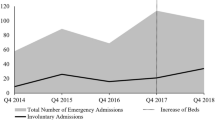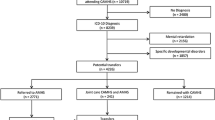Abstract
Background
Child and adolescent psychiatry services have historically been neglected in Ireland, in terms of resource provision and research.
Aim
To describe referral and admission patterns to an adolescent inpatient unit in Ireland.
Methods
We studied reasons for referral and admission decisions relating to all adolescents referred to St. Joseph’s Adolescent Inpatient Unit (AIPU), Dublin in the first 6 months following its establishment in 2009.
Results
Forty-one adolescents were referred during the study period; 46 % were admitted. There was no difference between those admitted and not admitted in terms of gender (two-thirds were female), age (mean age 16.2 years), most common reason for referral (depression, in almost one-in-two) and suicidality (present in one-in-two). Amongst those referred, 46 % were resident in the primary catchment area. While a majority of admissions occurred within 5 days of referral (53 %), a significant minority were not admitted until over 20 days after referral (16 %).
Conclusions
The demographic and clinical characteristics of adolescents referred and admitted to St. Joseph’s AIPU are consistent with national and international patterns. At national level, the opening of additional beds for adolescents (such as St. Joseph’s AIPU) has had positive effects on admission patterns; our findings indicate a need to further educate referrers about referral criteria, to optimise benefits derived from these new resources. Future studies could examine the potential roles of intensive support services in the community to further maximise use of scarce resources for this patient group.

Similar content being viewed by others
References
Expert Group on Mental Health Policy (2006) A vision for change: report of the expert group on mental health policy. The Stationery Office, Dublin
Guruswamy S, Kelly BD (2006) A change of vision? Mental health policy. Ir Med J 99:164–166
Health Service Executive (2010) Second annual child and adolescent mental health service report: 2009–2010. Health Service Executive, Dublin
Department of Health (2007) Mental Health Act 2007, chap 12. Department of Health, London
Department of Health (2009) Working together to provide age-appropriate environments and services for mental health patients aged under 18: a briefing for commissioners of adult mental health services and child and adolescent mental services. Department of Health, London
Kim-Cohen J, Caspi A, Moffitt TE, Harrington H, Milne JB, Poulton R (2003) Prior juvenile diagnoses in adults with mental disorder: developmental follow-back of a prospective-longitudinal cohort. Arch Gen Psychiatry 60(7):709–717
Healy E, Fitzgerald M (2000) A 16-year follow-up of a child inpatient population. Eur Child Adolesc Psychiatry 9:46–53
Tulloch S, Lelliott P, Bannister D et al (2008) Costs, outcomes and satisfaction for in-patient child and adolescent psychiatric services (COSI-CAPS). Royal College of Psychiatrists’ Research and Training Unit, London
O’Herlihy A, Worrall A, Banerjee S et al (2001) National In-patient Child and Adolescent Psychiatry Study (NICAPS). Royal College of Psychiatrists, London
Steinberg D, Galhenge DPC, Robinson SC (1981) Two years’ referrals to a regional adolescent unit: some implications for psychiatric services. Soc Sci Med E 15:113–122
Ainsworth P (1984) The first 100 admissions to a regional general purpose adolescent unit. J Adolesc 7:337–348
Pyne N, Morrison R, Ainsworth P (1985) A follow-up study of the first 70 admissions to a general purpose adolescent unit. J Adolesc 8:333–345
First MB, Spitzer RL, Gibbon M, Williams JBW (2002) Structured clinical interview for DSM-IV-TR axis I disorders, research version, patient edition (ECID-I/P). Biometrics Research, New York Sate Psychiatric Institute, New York
World Medical Association (2008) WMA declaration of Helsinki—ethical principles for medical research involving human subjects. World Medical Association, Ferney-Voltaire
Data Protection Commissioner (2007) Data protection guidelines on research in the health sector. Data Protection Commissioner, Dublin
O’Herlihy A, Lelliott P, Cotgrove A et al (2008) The care paths of young people referred but not admitted to inpatient child and adolescent mental health services. Royal College of Psychiatrists’ Research and Training Unit, London
Conflict of interest
There is no conflict of interest to declare.
Author information
Authors and Affiliations
Corresponding author
Rights and permissions
About this article
Cite this article
Wilson, L.S., Kelly, B.D., Morgan, S. et al. Who gets admitted? Study of referrals and admissions to an adolescent psychiatry inpatient facility over a 6-month period. Ir J Med Sci 181, 555–560 (2012). https://doi.org/10.1007/s11845-012-0817-6
Received:
Accepted:
Published:
Issue Date:
DOI: https://doi.org/10.1007/s11845-012-0817-6




